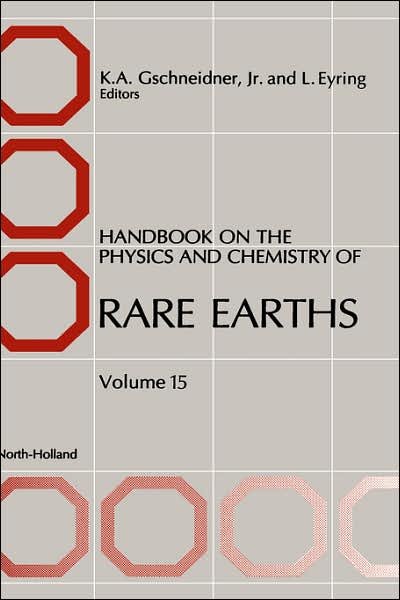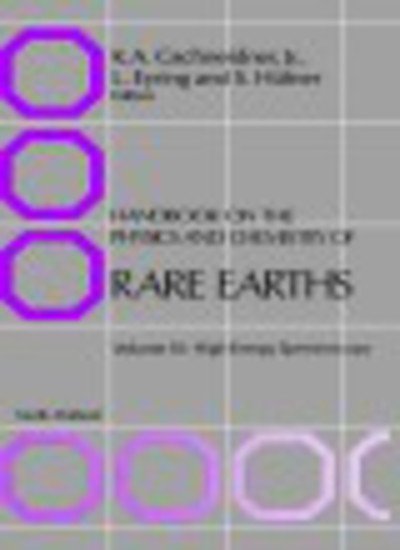
Tell your friends about this item:
Handbook on the Physics and Chemistry of Rare Earths - Handbook on the Physics & Chemistry of Rare Earths
Gschneidner
Handbook on the Physics and Chemistry of Rare Earths - Handbook on the Physics & Chemistry of Rare Earths
Gschneidner
Provides a review of rare earth carbides, emphasizing the thermodynamics, phase diagrams, crystal structures and physical properties. This book deals with the preparation, structure, chemical and physical properties of heavy-metal fluoride glasses. It explores the chemical kinetics of solvent and ligand exchange in aqueous lanthanide solutions.
Marc Notes: Editors vary.; On some vols.: 1st ed.; Vols. 5- distributed by: Elsevier Science Pub. Co.; Vol. 18 lacks distributor.; Vols. published by Elsevier.; Errata [for vols. 1-6]: v. 8, p. 375-378.; Includes separately published cumulative index volume for v. 1-15.; Includes bibliographical references and indexes.; Use copy; Restrictions unspecified;star; MiAaHDL; Volume 15 in this series continues the voyage of discovery started almost a decade ago. Chapter 98 adds significantly to an evaluation of systematic, experimental low-temperature studies of the ambivalent behaviours of cerium (ferromagnetism, antiferromagnetism, spin glass, superconductivity etc.) which depend upon its environment in materials. The conclusions arrived at should provide new data against which the theory can be advanced. The next chapter provides a review of rare earth carbides, emphasizing the thermodynamics, phase diagrams, crystal structures and physical properties. The binary rare earth carbides present an exceptionally wide range of compositions and structures both as solids and gas-phase molecules. Complex carbides with additional metal and non-metal components also receive attention. Metal-rich halides (i.e. compounds with an X/R ratioPublisher Marketing: Volume 15 in this series continues the voyage of discovery started almost a decade ago. Chapter 98 adds significantly to an evaluation of systematic, experimental low-temperature studies of the ambivalent behaviours of cerium (ferromagnetism, antiferromagnetism, spin glass, superconductivity etc.) which depend upon its environment in materials. The conclusions arrived at should provide new data against which the theory can be advanced. The next chapter provides a review of rare earth carbides, emphasizing the thermodynamics, phase diagrams, crystal structures and physical properties. The binary rare earth carbides present an exceptionally wide range of compositions and structures both as solids and gas-phase molecules. Complex carbides with additional metal and non-metal components also receive attention. Metal-rich halides (i.e. compounds with an X/R ratio Chapter 101 deals with the preparation, structure, chemical and physical properties of heavy-metal fluoride glasses. Large amounts of rare earths can be added into these, and they possess a great potential for optical applications in the mid-infrared range as fiber optic glasses for communication and transmission of information, optical wave guides, fiber lasers and sensors. The following chapter explores the chemical kinetics of solvent and ligand exchange in aqueous lanthanide solutions. A wealth of tabulated information on rate and equilibrium constants is provided in textual and tabular form. Chapter 103 considers the fundamentally important reactions of the lanthanide ions with water. These interactions are discussed for both solids and solutions. The hydrated species are considered in detail for the aqueous solution, revealing the consequences of the lanthanide series sequence. The concluding chapter reviews macrocyclic complexes formed by rare earth and dioxouranium ions as templates. Synthetic trends and reactivity are considered as well as potential uses of these intriguing wrap-around structures.
Contributor Bio: Unknown As a pediatrician, writer, wife, and mother, Perri Klass has demonstrated how medicine is integral to the health of families and communities, and how doctors themselves struggle to balance the conflicting needs of profession, self, and family. As medical director of Reach Out and Read, she encourages other pediatricians to foster pre-reading skills in their young patients. While earning her M. D. at Harvard, Klass contributed articles to "Mademoiselle" and "The New York Times" as well as to scientific and medical journals. She also wrote her first book, "A Not Entirely Benign Procedure "(1987), which chronicles her introduction to medicine and motherhood. In the following years she has continued to publish books, essays, award-winning short stories, a novel, and numerous articles, ranging from professional papers to popular journalism and travel pieces. Contributor Bio: Lemm, Jeffrey M Jeffrey M. Lemm is Research Animal Coordinator at Conservation and Research for Endangered Species (CRES) at the Zoological Society of San Diego. Contributor Bio: Author, Unknown Joseph Barber Lightfoot (13 April 1828 - 21 December 1889), known as J. B. Lightfoot, was an English theologian and Bishop of Durham. Lightfoot was born in Liverpool, where his father was an accountant. He was educated at King Edward's School, Birmingham, under James Prince Lee. His contemporaries included Brooke Foss Westcott and Edward White Benson. In 1847 Lightfoot went to Trinity College, Cambridge, and read for his degree along with Westcott. He graduated senior classic and 30th wrangler, and was elected a fellow of his college. From 1854 to 1859 he edited the Journal of Classical and Sacred Philology. In 1857 he became tutor and his fame as a scholar grew. He was made Hulsean professor in 1861, and shortly afterwards chaplain to the Prince Consort and honorary chaplain in ordinary to Queen Victoria. In 1866 he was Whitehall preacher, and in 1871 he became canon of St Paul's Cathedral. The Times wrote after his death that It was always patent that what he was chiefly concerned with was the substance and the life of Christian truth, and that his whole energies were employed in this inquiry because his whole heart was engaged in the truths and facts which were at stake. In 1875 Lightfoot became Lady Margaret's Professor of Divinity in succession to William Selwyn. In 1879 he was consecrated bishop of Durham in succession to Charles Baring. He soon surrounded himself with a band of scholarly young men. Lightfoot was never married. He died at Bournemouth and was succeeded in the episcopate by Westcott, his schoolfellow and lifelong friend. He served as President of the first day of the 1880 Co-operative Congress. Lightfoot wrote commentaries on the Epistle to the Galatians (1865), Epistle to Philippians (1868) and Epistle to the Colossians. In 1874, the anonymous publication of Supernatural Religion, a work speculated by some to be authored by Walter Richard Cassels, attracted attention. In a series of papers in the Contemporary Review, between December 1874 and May 1877, Lightfoot undertook the defense of the New Testament canon. The articles were published in collected form in 1889. About the same time he was engaged in contributions to William Smith's Dictionary of Christian Biography and Dictionary of the Bible, and he also joined the committee for revising the translation of the New Testament. The corpus of Lightfoot's writings include essays on biblical and historical, commentaries on Pauline epistles, and studies on the Apostolic Fathers.
| Media | Books Hardcover Book (Book with hard spine and cover) |
| Released | November 26, 1991 |
| ISBN13 | 9780444889669 |
| Publishers | Elsevier Science & Technology |
| Pages | 530 |
| Dimensions | 234 × 156 × 32 mm · 1.15 kg |
| Series Editor | Eyring, L. (Arizona State University, Tempe, AZ, USA) |
| Series Editor | Gschneidner, Karl A., B.S. University of Detroit 1952<br>Ph.D. Iowa State University 1957 (Iowa State University, Ames, USA) |


